| Glossary | ||
| Plants | Glossary Si-Sz |
| Plant | Plant | Time |
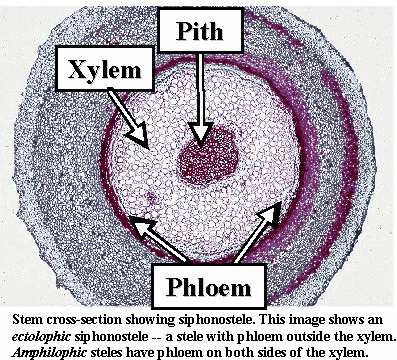
Simple tissue tissue composed of only one cell type
Siphonostele a type of stele in which the vascular tissue forms a cylinder around a central column of cellular or acellular pith. Compare protostele. Image from Prof. David Webb's (U. Hawaii) Botany 201 site.
Solute anything dissolved in a solvent. In salt water, the water is the solvent, and the salts are solutes.
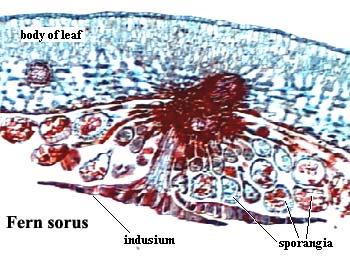
Sorus (pl sori) a cluster or group of sporangia of a fern; most frequently applied to clusters of fern sporangia attached to the bottom of fern leaves. Image from the General Biology Lab site by Diane Jokinen and Patrick Duffie of Loyola University Chicago.
Spline cell biology. In the developing spermatids of euphyllophytes, "a lamellar strip and a narrow band of microtubules ... which extend around the cell providing a framework for positioning of organelles." Renzaglia et al. (2000).
Sporangiophore modified branch on which the sporangium is attached.
Sporangium (pl. sporangia) hollow, unicellular or pluricellular structure in which spores are produced.
Spore a haploid (1N) reproductive cell capable of developing directly into a gametophyte without uniting with another cell.

Sporophyll a spore-bearing leaf (microphyll, not a "true" leaf); a modified leaf bearing sporangia. In some lycophytes, the megaspore (and so the developing megagametophyte) stay with the sporophyte and its sporophylls (i.e., the strobilus). It is fertilized in situ by microspores, and develops into sperm-producing microgametophytes. This lycopsid system is analogous, but clearly not directly related, to reproduction in the seed plants. Image from the Vascular Plant Image Library (Texas A&M Univ.).
Sporophyte the spore producing, diploid (2N) phase of the life cycle; compare to gametophyte.
Sporopollenin A major chemical constituent of the outer walls of plant spores. "The chemical composition of sporopollenin is not exactly known, due to its unusual chemical stability and resistance to degradation by enzymes and strong chemical reagents. Analyses have revealed a mixture of biopolymers, containing mainly long chain fatty acids, phenylpropanoids, phenolics and traces of carotenoids. Tracer experiments have shown that phenylalanine is a major precursor, but other carbon sources also contribute. It is likely that sporopollenin derives from several precursors that are chemically cross-linked to form a rigid structure." Wikipedia.
Stamen the "male" structures of a flower, consisting of a supporting filament and the anther, a sac which produces and holds the microgametophytes pollen).
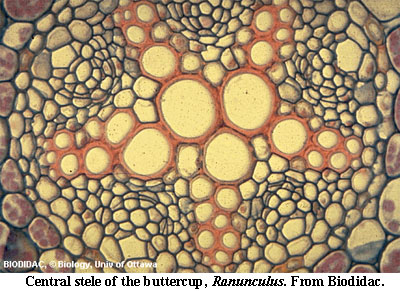
Stele vascular tissue (the xylem and phloem together) bundle; the vascular cylinder in stems and roots where the vascular tissue is located.

Sterome "The stems of many early polysporangiophytes [our tracheophytes] have a well-developed peripheral zone (sterome) consisting of several layers of thick-walled, decay-resistant cells ... . This zone is continuous in many zosterophylls, including Gosslingia, Sawdonia, and Crenaticaulis. No equivalent tissue has been recorded in the basal members of the Lycopodiales, and although thick-walled cortical tissues are present in extant Lycopodiaceae, these tissues are unlignified in the basal members of the clade (e.g., Huperzia)." Kenrick & Crane (1997).
Stigma (pl. stigmata) the distal part of the pistil, the organ that receives the pollen. Stigmata may be quite varied in shape and structure. They are often button-shaped and studded with hair-like papillae ("dry" stigmata) or coated with a sticky film ("wet" stigmata) to capture pollen.
Stigmarian originally meaning "similar to the roots of Stigmaria." As it turned out, stigmarian roots are neither roots nor attributable to a genus Stigmaria. Instead, they are the basal branch systems of tree-like lycopsids. Stigmarian "root" systems probably lay on, or just under, the surface, with a photosynthetic upper surface. They radiate from the central axis and bifurcate equally, as do lycopsid branches. The "roots" bear scars which probably, like the scars on lycopsid branches, indicate the positions of small (microphyllous) leaves. Prof. Ralph Taggart (Michigan State Univ.) has some good images at Arborescent Lycopods.
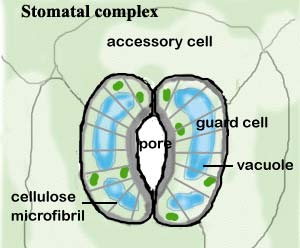
Stoma (pl. stomata) tiny pores or opening in the epidermis of leaves; stomata are flanked by two guard cells that regulate opening and closing of the pore and thus regulate gas exchange (respiration) and transpiration. Image from the Ecotree site by Martin Cocks of the University of the Western Cape (South Africa).
Strobilus (pl. strobili) a cone a cone-shaped cluster of spore-bearing leaves (e.g., a pine cone), an aggregation of sporophylls on a common axis. Kenrick & Crane (1997) define strobili as "aggregations of micro- and megasporangiophores, typically around an unbranched determinate axis." They note that all strobili are not necessarily homologous: "strobili usually comprise sporangia and the associated sporangiophores, which are clearly modified microphylls in lycopsids, are probably highly modified megaphylls in seed plants, and are reduced branches in the Equisetopsida. In the Zosterophyllopsida, sporangia are aggregated into strobili in which microphylls and sporophylls are generally absent ("naked strobili" ...). Early fossil members of the Euphyllophyta, including taxa in the Spermatophytata, Equisetopsida, and Filicopsida stem groups, seldom possess strobili although sporangia are typically aggregated into terminal clusters (e.g., Psilophyton ...)."
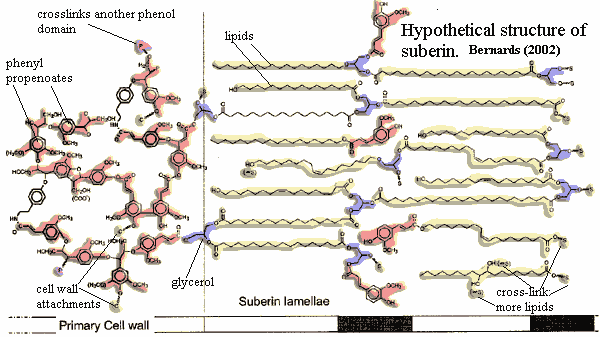
Suberin waxy, waterproof chemical in some plant cells, notably cork (in stems) and endodermis cells (in roots). Suberin is an extremely complex and irregular material, like lignin -- with which it shares some similarities. Suberin is composed of two physically separated domains: the aliphatic and phenolic. The phenolic domain is rather lignin-like, but with even greater variability, and built on the same basic unit of a di- or tri-hydroxyphenyl group attached to a three-carbon chain, variously oxidized and integrated with the carbohydrates of the cell walls. Perhaps the most common building block is ferulic acid: formally, 3-(2'-methoxy-3'-hydroxyphenyl)-propenoic acid. Distally, the phenolic domain is attached at points by ester linkages to glycerol. The remaining hydroxyls of the glycerol molecule are ester-linked to some strange-looking C-18 to C-30 lipids. These lipids are substituted at C9-10 with one or two hydroxyls, or even with an epoxide link between the two carbons. Finally the ω position may be oxidized to a carboxylate (alone or esterized to glycerol) or hydroxyl (alone or esterised to ferulic acid). Variations allow for cross-linkage to other suberin molecules via the 9-10 or ω positions. Image adapted from Bernards 2002).
Style a tubular column in the pistil of a flower, through which the pollen is transported from the stigmata to the ovary.
Succulent a plant that is able to store water in its tissues and then withdraw it during times of drought. e.g. a cactus. The water storage tissue may be found in the stem, leaves, or roots depending on the species. Stem succulents, leaf succulents, and root succulents are types of growth forms.
Sympodial of branching patterns. Sympodial branching is a a developmental pattern in which branches arise from division of the apical meristem. That is, the growing tip of the plant simply divides in two, although the division may not be equal. A new growth axis is not formed. Instead, the old axis heads off in two different directions. Compare monopodial, pseudomonopodial. These terms are also used with reference to growth patterns of rhizomes, flowers, etc. They are also quite frequently used wrongly. Some writings define these terms by reference to the branch angle. Sympodial branches are typically <45° from the vertical axis, but the term sympodial refers to a development course, not gross morphology. Other materials restrict monopodial to ?multiple) branches from nodes. That's closer, but too restrictive. It misses the evolutionary point and isn't consistent with the established use of this term in paleobotany.
Synapomorphy a unique character which is shared by all basal members of a clade and is derived from their common ancestor, but not shared with ancestral groups. A synapomorphy may be secondarily lost in later descendants. Only a synapomorphy may be used to infer phylogeny.
page ATW090410
checked ATW080305
modified ATW090601